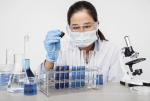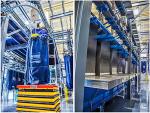CHICAGO — Health concerns, in the form of emerging or increasing pathogens, have always been a public concern.
When these scares take place, laundry operations need to ensure that how they are processing goods results in clean, hygienic linens.
However, the past few years with the pandemic and then monkeypox have shined a spotlight on the laundry and linen services industry, and this has caused everyone to use a microscope on operations’ wash chemistry.
American Laundry News communicated with five chemical company representatives (Jack Heaviside, senior consultant-specialty markets for Sunburst Chemicals; Chad Dare, executive vice president of sales, Pariser Industries; Graham Skinner, vice president of business development and technical support for UNX-Christeyns; Annie Thomas, Ecolab’s senior marketing communications manager; and Leonardo Gastelum, national accounts director for Norchem Corp.) to find out how laundry chemistry has changed and what operators need to know and do today.
What did COVID-19 and monkeypox do to the focus on laundry chemistry?
HEAVISIDE: Ensuring all processed textiles were meeting hygienically clean outcomes. Additionally, the importance of equipment cleaning, specifically that CBWs (continuous batch washers) and presses are monitored for bio-film. Temperature and linen processing were a significant focus of all laundry operators.
DARE: The onset of COVID-19 raised the awareness of good hygiene in everyone in general and, naturally, in laundering operations specifically.
Our laundry chemical customers had many questions regarding these and other novel viruses and wanted reassurance that their linens were being disinfected and made hygienic.
SKINNER: In many cases, it created an atmosphere of hypersensitivity. The chain of interest in laundry operations seemed to run higher up the organization charts in both laundries and laundry customers.
THOMAS: COVID-19 and monkeypox significantly heightened the focus on laundry chemistry within the commercial laundry industry. These health concerns underscored the critical importance of effective disinfection and sanitation in laundry processes.
As a response, Ecolab intensified its commitment to providing cutting-edge laundry chemistry solutions, such as the EPA-approved AdvaCare™ Disinfectant, which is effective against SARS-CoV-2, the virus responsible for COVID-19.
GASTELUM: COVID-19 and monkeypox accelerated the need for real-time and accurate virus detection methods to prevent the spread of viruses.
Did anything regarding chemistry change because of these health concerns? If so, what?
HEAVISIDE: For us, the answer is no. From a global perspective, subpar suppliers of chemistry were taxed with playing catchup with those that had always focused on hygiene as part of their chemical program.
DARE: I don’t believe chemistry of laundering changed as much as the attention to detail did as it related to washroom conditions and linen handling procedures.
In some cases, additional products such as a bacteria-static agent were added to certain soil applications such as healthcare-related linens classes.
SKINNER: The C-19 virus is killed in a traditional wash process. One thing that changed was a higher attention level as it relates to reporting and proper operation of equipment to provide and document proper sanitation of product.
The arrival of monkeypox heightened the awareness and replayed the narrative that was occurring with C-19, although it did not seem to materialize and cause the same level of concern in the long run.
THOMAS: Yes, health concerns prompted substantial changes in laundry chemistry. Ecolab developed and enhanced disinfection formulations, including the AdvaCare Disinfectant, specifically designed to combat viruses like SARS-CoV-2.
These changes involved rigorous research and development efforts and partnerships with regulatory agencies, ensuring the chemistry met the highest hygiene standards while also being environmentally sustainable.
GASTELUM: The only change with these types of bacteria is to ensure that hot water is satisfying at 160 F with the proper wash time and detergents. At this temperature, it can ensure hygienically clean standards are met.
What were the challenges in producing hygienic goods?
HEAVISIDE: Keeping plant operators, as well as infection control teams, from panicking. Specific areas: Raising temperatures in the washers, discarding textiles that had been exposed to the COVID virus, purchasing excessive non-durable goods.
DARE: Apart from the challenges caused by global supply-chain shortages, we faced the difficulty of providing “feet on the ground” technical service assistance to our customer base due to their isolation mandates and our own employee health concerns.
SKINNER: One big challenge was supply-chain issues. Getting products and services from A to B, obtaining supplies like PPE (personal protective equipment).
Early on, there seemed to be a lack of information and what was, and became, available seemed to vary across different laundry markets somewhat.
In healthcare, interpretation, by some, of regulations and recommendations took on a life of its own. New hoops to jump through were popping up everywhere.
THOMAS: Producing hygienic goods during the COVID-19 pandemic presented multifaceted challenges. It necessitated stringent adherence to guidelines, increased disinfection measures, and the selection of effective laundry chemicals.
Ecolab addressed these challenges by offering solutions like AdvaCare Disinfectant, which not only meets hygiene standards but also outperforms traditional oxidizers, such as chlorine and peroxide.
GASTELUM: The challenges I noticed since the outbreak of COVID-19 and monkeypox are making sure to always wear gloves and wash your hands properly before and after handling contaminated goods. Wearing proper safety equipment to prevent the spread of viruses.
Over the past year, what have your laundry customers needed, and what recommendations have you given them?
HEAVISIDE: The pandemic changed the thought process of all operators and users. For us, we kept the conversations simple: Enhanced monitoring of PM (preventative maintenance) schedules, ensuring that temperature and wash/finish times were not impacted by concerns that, frankly, existed prior to the pandemic.
DARE: With the ongoing issue of finding and retaining competent washroom staffing, our laundry customers’ need for enhanced training has become a critical role of our group.
Our customers have always been looking for more efficient ways to accomplish proper wash quality, to reduce labor, linen rag-out, and increase production, but over the past year, we have found that good reliable training of laundry staff has become a more frequent and critical component of successful laundry operations and our role in that process.
SKINNER: A closer, consultative relationship developed along with a higher interest in sharing best practices. They have needed help in preparing for various inspections and certifications.
THOMAS: Over the past year, our laundry customers needed assurance of the safety and hygiene of their laundered goods.
Ecolab recommended the use of AdvaCare Disinfectant, which offers the highest level of cleanliness, an emerging viral pathogen claim against SARS-CoV-2, and sustainable disinfection capabilities.
We also provided guidance on implementing standardized cleaning and hygiene protocols and training staff to ensure correct protocol and product application.
Ecolab has a wide range of hard surface disinfectants, hand soaps and sanitizers to ensure linens are not just laundered but handled with the highest level of cleanliness throughout the laundry operation.
GASTELUM: The needs I’ve encountered have been more frequency of checking titrations to assure chemicals are within acceptable range to kill bacteria.
Preventative measures have also been taken more seriously with equipment malfunctions to be certain that the wash equipment is working at its optimal performance.
From your perspective, how can an operation best evaluate its chemistry in order to best serve its customers?
HEAVISIDE: The obvious ones are odor and color as they are easy to see. Third-party testing of finished goods along with swatch testing are analytical ways to look at the entire laundering process.
DARE: Communication with us is key. Developing standards for washroom conditions and procedures related to soil sorting, formula selection, linen and stain handling and management are integral to a successful laundry operation.
Additionally, a laundry can evaluate/test their goods through third-party testing laboratories to ensure certain elements of proper laundering are met (i.e., brightness/whiteness, sanitation, stain removal, etc.)
SKINNER: To me, it’s all about the balance between quality, service and value that they receive from the chemical program that they are using. Value is not the same as cost.
Higher involvement and service levels from their vendor can lead to higher, consistent quality which provides for more value and in most cases, provides more to their customers.
THOMAS: To best serve customers, laundry operations should collaborate with experts to evaluate their chemistry. We recommend conducting microbial testing, monitoring wash parameters and optimizing chemical dosing to meet specific customer needs.
Regularly reviewing and updating processes and chemicals, based on data-driven insights, is essential to maintaining high hygiene standards.
Check back Thursday for the conclusion with questions about employee knowledge and challenges, future concerns, and final thoughts.
Have a question or comment? E-mail our editor Matt Poe at [email protected].






















































































































































































































































